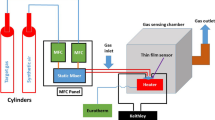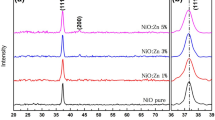Abstract
Detection characteristics of elementary tellurium (Te) nanocrystalline thin film for nitrogen dioxide (NO2) gas detection are presented. An electron beam evaporation method (eBE) was used to deposit elementary Te ultrathin nanocrystalline films at room temperature, with the thickness from 10 nm to 40 nm. An intermittent deposition method was employed to regulate the distribution of grains during the whole film deposition process. A type of compact and continuous nanocrystalline film structure was confirmed by x-ray diffraction and transmission electron microscopy analysis. Such a structural feature of thin films is able to provide a continuous grain boundary, which can increase the surface-to-volume ratio and further improve the sensitivity of the sensors. The effects of film thickness and gas concentration with respect to the sensor performance have been evaluated. The sensor presents a ppm (parts per million)-level NO2 detection limit in an atmospheric environment, and the maximum sensitivity is up to 7.926 × 105 ppm−1. In addition, a complete evaluation demonstration system was developed for a NO2 concentration real-time monitor, which provides the possibility for the sensor to be applied to actual environmental monitoring.




Similar content being viewed by others
References
M. Amani, C. Tan, G. Zhang, C. Zhao, J. Bullock, X. Song, H. Kim, V.R. Shrestha, Y. Gao, K.B. Crozier, M. Scott, and A. Javey, Solution-synthesized high-mobility tellurium nanoflakes for short-wave infrared photodetectors. ACS Nano 12, 7253 (2018).
J.J. Loferski, Infrared optical properties of single crystals of tellurium. Phys. Rev. 93, 707 (1954).
A. Pradhan, A. Roy, S. Tripathi, A. Som, D. Sarkar, J.K. Mishra, K. Roy, T. Pradeep, N. Ravishankar, and A. Ghosh, Ultra-high sensitivity infra-red detection and temperature effects in a graphene–tellurium nanowire binary hybrid. Nanoscale 9, 9284 (2017).
Y. Wang, G. Qiu, R. Wang, S. Huang, Q. Wang, Y. Liu, Y. Du, W.A. Goddard, M.J. Kim, X. Xu, P. Ye, and W. Wu, Field-effect transistors made from solution-grown two-dimensional tellurene. Nature Electr. 1, 228 (2018).
C. Zhao, C. Tan, D.-H. Lien, X. Song, M. Amani, M. Hettick, H.Y.Y. Nyein, Z. Yuan, L. Li, M.C. Scott, and A. Javey, Evaporated tellurium thin films for p-type field-effect transistors and circuits. Nat. Nanotechnol. 15, 53 (2020).
S. Lin, W. Li, Z. Chen, J. Shen, B. Ge, and Y. Pei, Tellurium as a high-performance elemental thermoelectric. Nat. Commun. 7, 1 (2016).
W. Wang, C. Li, X. Li, Y. Jia, F. Jiang, C. Liu, R. Tan, and J. Xu, Fabrication of freestanding tellurium nanofilm and its thermoelectric performance. Thin Solid Films 654, 23 (2018).
D. Tsiulyanu, Tellurium thin films in sensor technology. Nanotechnol. Basis Adv. Sens. (2011). https://doi.org/10.1007/978-94-007-0903-4_38.
W. Wu, G. Qiu, Y. Wang, R. Wang, and P. Ye, Tellurene: its physical properties, scalable nanomanufacturing, and device applications. Chem. Soc. Rev. 47, 7203 (2018).
D. Wang, A. Yang, T. Lan, C. Fan, J. Pan, Z. Liu, J. Chu, H. Yuan, X. Wang, M. Rong, and K. Nikhil, Tellurene based chemical sensor. J. Mater. Chem. A. 7, 26326 (2019).
S. Sen, K. Muthe, N. Joshi, S. Gadkari, S. Gupta, M. Roy, S. Deshpande, and J. Yakhmi, Room temperature operating ammonia sensor based on tellurium thin films. Sens. Actuators, B Chem. 98, 154 (2004).
T. Siciliano, M. Di Giulio, M. Tepore, E. Filippo, G. Micocci, and A. Tepore, Tellurium sputtered thin films as NO2 gas sensors. Sens. Actuators, B Chem. 135, 250 (2008).
D. Tsiulyanu, S. Marian, V. Miron, and H.-D. Liess, High sensitive tellurium based NO2 gas sensor. Sens. Actuators, B Chem. 73, 35 (2001).
D. Tsiulyanu, and O. Mocreac, Concentration induced damping of gas sensitivity in ultrathin tellurium films. Sens. Actuators, B Chem. 177, 1128 (2013).
D. Tsiulyanu, I. Stratan, A. Tsiulyanu, H.-D. Liess, and I. Eisele, Investigation of the oxygen, nitrogen and water vapour cross-sensitivity to NO2 of tellurium-based thin films. Sens. Actuators, B Chem. 121, 406 (2007).
D. Tsiulyanu, A. Tsiulyanu, H.-D. Liess, and I. Eisele, Characterization of tellurium-based films for NO2 detection. Thin Solid Films 485, 252 (2005).
L. Guan, S. Wang, W. Gu, J. Zhuang, H. Jin, W. Zhang, T. Zhang, and J. Wang, Ultrasensitive room-temperature detection of NO2 with tellurium nanotube based chemiresistive sensor. Sens. Actuators, B Chem. 196, 321 (2014).
D. Tsiulyanu, and A. Moraru, Nanocrystalline tellurium films: fabrication and gas sensing properties. Nanosci. Adv. CBRN Agents Detect., Inf. Energy Secur. (2015). https://doi.org/10.1007/978-94-017-9697-2_40.
T. Siciliano, E. Filippo, A. Genga, G. Micocci, M. Siciliano, and A. Tepore, Single-crystalline Te microtubes: synthesis and NO2 gas sensor application. Sens. Actuators, B Chem. 142, 185 (2009).
D.-S. Lee, S.-D. Han, J.-S. Huh, and D.-D. Lee, Nitrogen oxides-sensing characteristics of WO3-based nanocrystalline thick film gas sensor. Sens. Actuators, B Chem. 60, 57 (1999).
H. Sun, Q. Wei, Q. Su, X. Zhu, P. Wangyang, X. Gao, and D. Yang, Purely physical fabrication of 10 cm × 10 cm, highly uniform PbI2 thin films on rigid and flexible substrates for x-ray photodetection application. APL Mater. 8, 031108 (2020).
M. Venkatachalam, M. Kannan, S. Jayakumar, R. Balasundaraprabhu, A. Nandakumar, and N. Muthukumarasamy, CuInxGa1−xSe2 thin films prepared by electron beam evaporation. Sol. Energy Mater. Sol. Cells 92, 571 (2008).
T.-S. Yang, C.-B. Shiu, and M.-S. Wong, Structure and hydrophilicity of titanium oxide films prepared by electron beam evaporation. Surf. Sci. 548, 75 (2004).
W. Zheng, Y. Xu, L. Zheng, C. Yang, N. Pinna, X. Liu, and J. Zhang, MoS2 Van der Waals p–n junctions enabling highly selective room-temperature NO2 sensor. Adv. Func. Mater. 30, 2000435 (2020).
Acknowledgments
This work was supported by the National Natural Science Foundation of China (NSFC) under Grant No. 62005029 and Sichuan Science and Technology Research Foundation under Grant No. 2021YFG0010.
Author information
Authors and Affiliations
Corresponding author
Ethics declarations
Conflict of interest
There are no conflict to declare.
Additional information
Publisher's Note
Springer Nature remains neutral with regard to jurisdictional claims in published maps and institutional affiliations.
Supplementary Information
Below is the link to the electronic supplementary material.
Rights and permissions
Springer Nature or its licensor (e.g. a society or other partner) holds exclusive rights to this article under a publishing agreement with the author(s) or other rightsholder(s); author self-archiving of the accepted manuscript version of this article is solely governed by the terms of such publishing agreement and applicable law.
About this article
Cite this article
Wei, Q., Su, Q., Liu, Y. et al. Ultrathin Elementary Te Nanocrystalline Films Prepared by Pure Physical Method for NO2 Detection. J. Electron. Mater. 52, 1900–1907 (2023). https://doi.org/10.1007/s11664-022-10154-3
Received:
Accepted:
Published:
Issue Date:
DOI: https://doi.org/10.1007/s11664-022-10154-3




